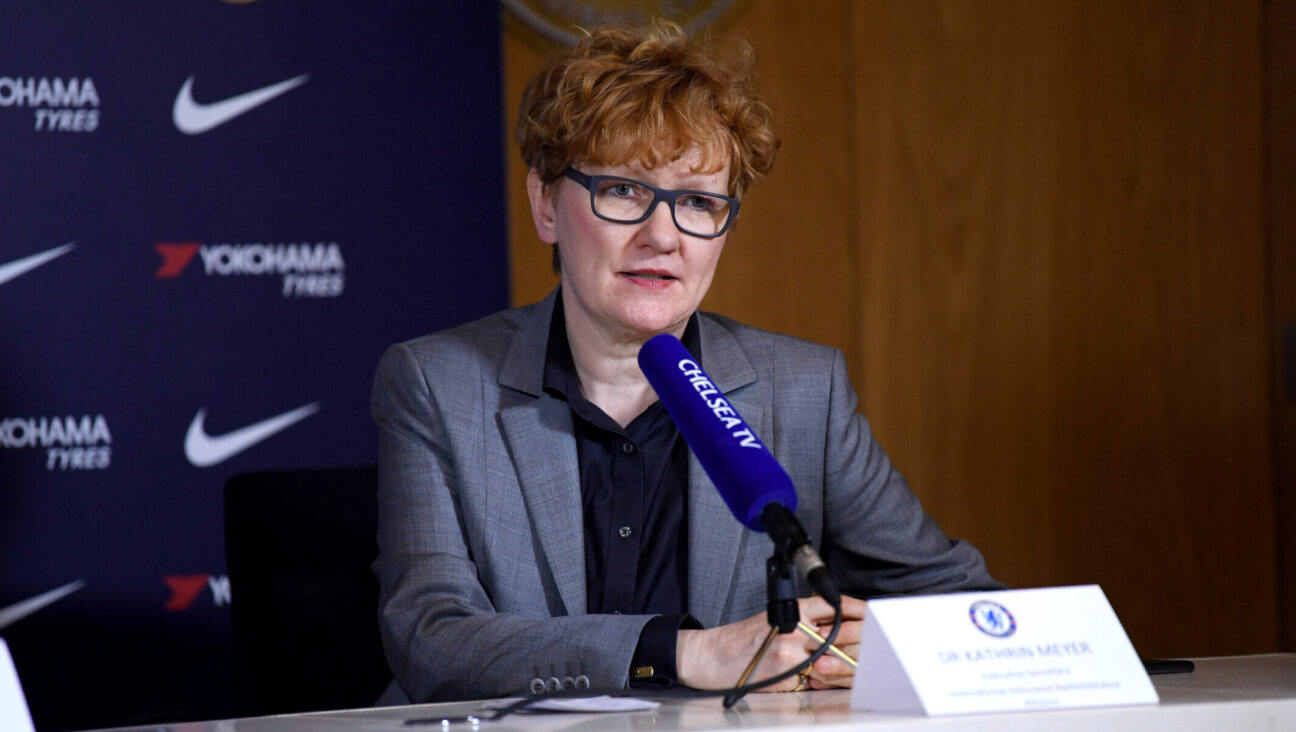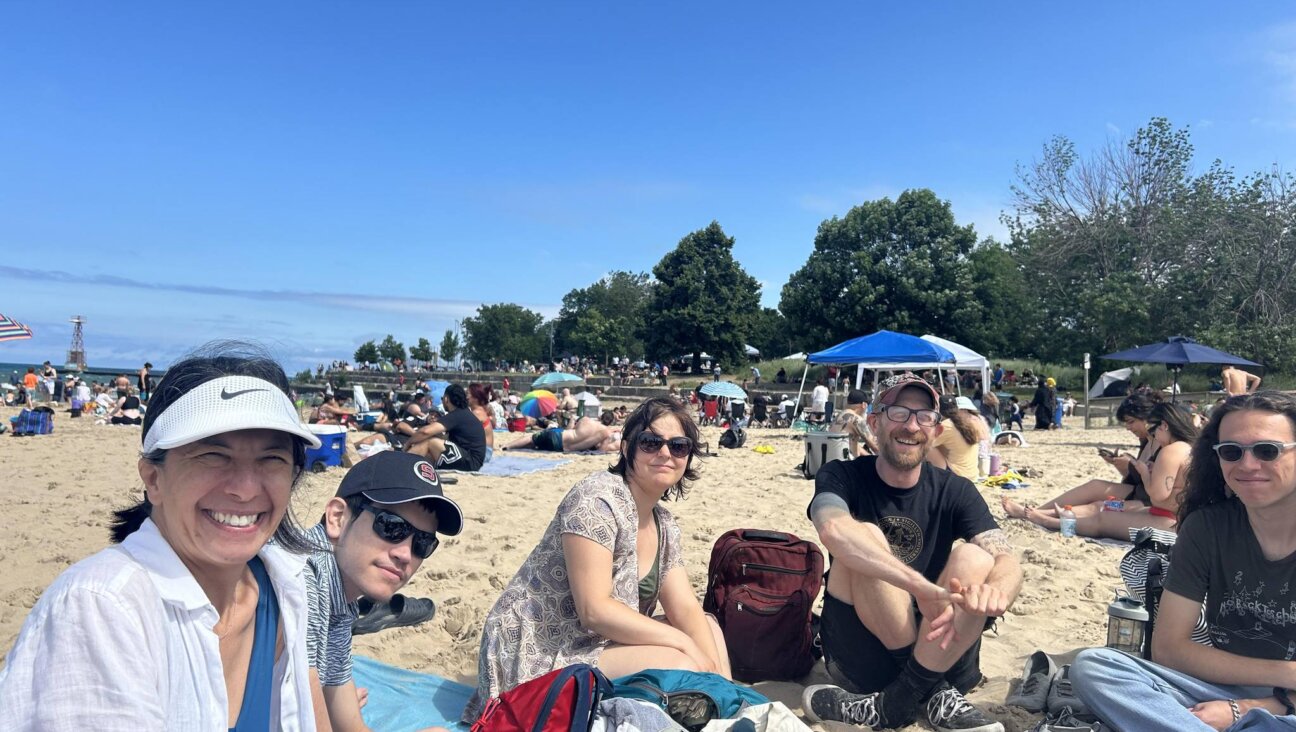The Torah That Ended Up At A Goodwill Doesn’t Belong To A Jew

Image by Carlos Bernate
For Jill Hyman, a Torah is an etz chaim, the tree of life and the “source of Jewish existence.” She refers to a scroll as “she,” as though she knows it personally.
So when Hyman, the administrator of Temple Beth El in Williamsburg, Va., got a call a little over two weeks ago about a Torah that was up for auction on ShopGoodwill.com, she felt appalled — and profoundly drawn to the scroll. Its mantle bore the name of a small town in Ukraine, the country at the center of the current impeachment inquiry. One of Hyman’s daughters had just celebrated her bat mitzvah; she imagined the last bar mitzvah boy to read from the scroll before the Nazis liquidated the Jews of the town, Berdichev.
“Clearly it means something,” she said then. “She belongs to the Jewish people.”
Now Hyman is grappling with a new, unexpected reality: that the Torah rightfully belongs to a retired real estate agent who lives about a 90-minute drive away in Spotsylvania, Va., who once came close to playing professional football and spent years collecting religious objects. And who is not Jewish.
The Forward first reported on the Goodwill Torah on Nov. 6, chronicling how it had been dropped off at a Williamsburg thrift store and then, after weeks on a shelf with a $500 price tag, bought by someone hoping to flip it for a profit. The unknown buyer, however, soon returned it to a Goodwill in Richmond, from where it was posted to the online shop. But the article raised more questions: Where was the Torah from? How did it end up in Williamsburg? Who did it really belong to?
Two weeks of further investigation has allowed us to reconstruct the last two decades of the Torah’s life, tracing a surprising odyssey through a world little known to Jews in which the sacred scrolls are not reserved for ritual reading, but are collectibles of fluctuating value bought and sold by bible enthusiasts.
We still don’t know the Torah’s true age or origins, and will likely never know. But we discovered that it was sold in the 1990s by a Judaica store on Manhattan’s Lower East Side to the owner of a traveling bible museum in Texas, who soon sold it through a middle man to the Virginia real estate agent, a Christian collector who, earlier this year, consigned it to an auction house outside of Washington, D.C.
The auction house couldn’t sell it — and can’t fully explain why it went to Goodwill.
“I’m not holding anything against anybody,” said the real estate agent, Mel Meadows, who is 69 and occasionally quotes from the Talmud. “I just want my property back.”

Parts of the scroll show significant tears or appear to have smoke or water damage. Image by Carlos Bernate
‘A Torah from pieces’
Meadows did not see the Forward’s original article about the Torah. In fact, he only learned that it had ended up in a Goodwill after I contacted him. But a rabbi who worked at the auction house last winter saw it, recognized the Torah, and reached out. After talking to him, I was able to reverse-engineer the story back a few more chapters. To read our first article about the Torah, click here.
Every new bit of information surprised me: I grew up under the impression that Torahs were created by scribes, lived in synagogues, day schools and summer camps, and then, when they became too worn for use, were buried in genizahs, the special repository for retired Jewish texts.
It turns out that Torahs, one of the holiest objects in Judaism, sometimes have lives completely outside the faith. This story helps illuminate that world, revealing that, like it or not, there are many non-Jews in the United States who find value and use in an old, worn, handwritten Hebrew scroll.
What we know of the Goodwill Torah’s life starts in the heart of what once was the Jewish mecca of the Lower East Side, in a former tenement building on Essex Street that will soon be replaced by a sleek tower of “micro-units.” Today, the gentrifying block is home to cafes and a pilates studio, but 20 years ago it was still a row of hole-in-the-wall Judaica shops.
At 11 Essex, three rabbis operated A & Y Sofrei Stam, a storefront where a scribe examined and repaired the parchment scrolls in tefillin, the leather boxes worn for weekday morning prayers, and in mezuzahs, which are mounted on the doorposts of a Jewish home.

Rabbi Aaron Lichter checking a pair of tefillin inside A & Y Sofrei Stam, in a photograph taken in 1997 for a New York Times story about the store. Credit: Michelle V. Agins/The New York Times
In the 1990s, A & Y was crammed floor to ceiling with ornaments, scroll-repair supplies and as many as 40 Torah scrolls at a time, recalled Rabbi Michael Schiffman, who at the time operated his own small business, Havdalah Judaica, from a desk inside the store. Schiffman, now 64 and living in Florida, back then bought Torahs from shuttered synagogues and via brokers, who collected unused scrolls around Europe and sold them to shops in the United States and Israel.
Schiffman told me that the Goodwill Torah was one of those scrolls, and that it was considered a “Torah from pieces” because it had panels from several different eras and places, perhaps dating as far back as the 1600s. Schiffman didn’t recall the shop repairing the scroll, meaning it was likely unfit for ritual use, unlike the majority of the scrolls they sold.
“Some of them you look at, and it can take your breath away,” he said. “That one, it was an older scroll. It wasn’t particularly wonderful.”
Neither Schiffman nor Franklin “Rusty” Maisel, a dealer in rare bibles, recall the exact year that Maisel came to Havdalah and bought the Torah, saying it was bound for a museum.
Maisel was born Jewish but converted as a young man to Christianity, and for more than two decades has operated a traveling bible museum. He says the museum — which includes multiple Torah scrolls and a working, scale model Gutenberg press on which he demonstrates early printing methods — is his way of spreading enthusiasm for the bible.
“I try to teach respect for the Torah, which a lot of Christians don’t understand,” said Maisel, who is 75 and lives outside Fort Worth, Tex. “We are basically Christian believers. But what is a Christian is an interesting thing. Like what is a Jew? People have different definitions.”
Maisel was part of a spike in trade in the late 1990s in rare bibles and Judaica fueled largely by eBay, which allowed collectors to obtain a scroll fragment here, a Gutenberg bible leaf there. He estimates that he sold about 12 full Torahs over the years. Neither he nor Schiffman remembers what he paid for the Goodwill Torah.
Schiffman no longer trades in Torahs, but the deep admiration for the scrolls and their scribes that he felt while working on Essex Street remains. He told me he was “embarrassed” at what became of the Torah after it left the Lower East Side, even though he knows it wasn’t his fault.
“It’s not a piece of furniture,” he said. “It’s something holy and special. It’s the history of our people.”
‘Scripture is the experiences of those who have gone before us.’
Around 2000, Maisel said, he sold the Torah to Paul Barkocy, a pastor who handled rare-bible sales for, he contends, businessmen including the former presidential candidate Ross Perot. Again, neither Maisel nor Barkocy could tell me the sale price.
Barkocy said he had planned to resell the Torah quickly, and at his request Maisel created a letter attesting to the Torah’s provenance, whose claims are somewhat dubious.
The letter says that a Rabbi Yitzchak Goldstein had determined the scroll was written in the 1400s, adding: “Because of its age, quality, and source Rabbi Goldstein thinks the scroll should be recognized as an extraordinary and historically significant Torah.” It also identified Berdichev, the name on the Torah’s mantle, as the birthplace of a founder of Hasidic Judaism.
Goldstein could not be reached to verify this. Schiffman, the rabbi who once worked on Essex Street, said “Goldstein” was in fact a pseudonym the scribe used to hide his earnings from an ex-wife, and declined to share his real name. The founder mentioned in Maisel’s letter, meanwhile — Rabbi Levi Yitzchak of Berdichev — was not a founder of Hasidic Judaism, and he produced no rabbinic dynasty, though he was an influential figure in the movement, experts say.
(Schiffman, for his part, thinks the Torah likely came from Germany, where the Jewish communities were wealthy enough to afford such a large scroll.)
Armed with the certificate, Barkocy sold the Torah to Meadows, the Virginia real-estate agent, who punted for the Washington Redskins in two pre-seasons in the early 1970s, but never played a regular-season game. Meadows told me he was fascinated by its purported historical significance; it would go well with the Torah scroll fragments he already had framed in his home.

Mel Meadows in his home outside Fredericksburg. A framed fragment of a Torah scroll hangs over his fireplace, above a shofar. Image by Carlos Bernate
Barkocy recalled bringing the Torah to the large house Meadows was living in at the time in Fredericksburg, Virginia. Curious to see if it was complete, the two unfurled the scroll, with the help of Meadows’ wife and son, along the longest corridor in the home, searching for notable passages like the Ten Commandments. Meadows said they made sure not to let it touch the ground, a grave mistake in Judaism.
“From Genesis to Deuteronomy, it was all laid out,” Meadows said.
Meadows is a self-taught scholar of religion and rare bibles who, in an interview, mentioned the shifting names of God and the 70 interpretations that the ancient rabbis said could be found in every verse. For more than two decades, he collected hundreds of rare bibles and religious ornaments worth hundreds of thousands of dollars, including a bible from the American Revolution and a copy of the William Tyndale bible, whose translation got its creator burned at the stake.
“To me, scripture is the experiences of those who have gone before us,” he said, “as they are dealing with the mystery of God.”

Meadows holds the wimpel, or belt, that accompanied the Goodwill Torah when he bought it. He gave the wimpel to the photographer to bring to Beth El, so the Torah would be complete. Image by Carlos Bernate
‘The book was never kosher’
In 2009, after two real-estate investments flopped and Meadows had to pay significant out-of-pocket costs for his wife’s heart surgery, he consigned much of his collection — though not the Torah — to auction in New York. He says the bulk of it brought about $250,000.
This year, downsizing in order to move closer to his children, he hired Quinn’s Auction Galleries, about a half hour outside Washington, D.C., to sell the rest — including our Torah.
Rabbi Howard Gorin, who Quinn’s hired last winter to assess the value of the library of a deceased rabbi, told me that he examined the Berdichev Torah, and was unable to corroborate Maisel’s letter of authenticity.
Still, the Torah went up for auction in May alongside the dead rabbi’s books and Judaica. Meadows had set a sale minimum of $4,000, but there were no qualifying bids.
“The book was never kosher,” noted Matthew Quinn, executive vice president of the auction house. It’s “an assemblage, it’s not necessarily real, so to speak, and that presents a challenge.”
Quinn acknowledges that when the Torah didn’t sell, it should have been returned to Meadows. When I first called the Quinn’s office, Quinn himself assumed it had been, since that’s what they do with valuable items that fail to sell at auction. It was only later, when Meadows told me he never got it back, that it became clear someone at Quinn’s had dropped the ball.
When I called Quinn back, he said the Torah seemed to have mistakenly been included in a load of unsold items marked for donation to thrift stores and charities. The employee who was supposed to give the Torah back to Meadows lived in Williamsburg, Quinn said, which may explain why it ended up in the Goodwill store there.
Now, Quinn says that he is planning to work with Temple Beth El, the Williamsburg synagogue caring for the Torah, to get it back to Meadows.
“This was obviously an unfortunate decision, and we’ll work on getting to the bottom of it, and making sure that something like this doesn’t happen again,” he said.

The Torah at Beth El. Image by Carlos Bernate
‘It’s almost like we found a child’
When Hyman brought the Torah back to Beth El, an unaffiliated congregation with about 150 member-families, it was the toast of the synagogue. People came to examine it, despite its strong smell of mold. They set it in an ark, to join their collection of Torahs that includes a tall, thin scroll that survived the Holocaust in Czechoslovakia. For Beth El’s leader, Rabbi David Katz, the whole episode has in part underscored how unfamiliar most people in their town — where Beth El is the only synagogue — are with Judaism.
“It’s almost like we found a child,” explained Katz. “And yet, nine out of 10 people around here wouldn’t understand what it is.”
The congregation had been planning to hire a scribe to examine the Torah, and estimate the cost to repair it.
But Meadows wants it back, which makes Hyman — the synagogue administrator who calls the scroll “she” — uncomfortable.
She is skeptical of the auction-house story, that the Torah got lost by mistake. She is also unnerved that this Torah — and many others — live their lives in Christian hands.
“I feel like the whole story is how an etz chaim, this Jewish lifeline and connection to the Jewish people, is being culturally appropriated,” she said.
When Hyman first got the call about the Torah from Goodwill she was on her way to a bris, the ritual circumcision of an eight-day old boy. She immediately turned around to grab another Beth El member and go get the Torah, figuring the infant would forgive her absence.
“God willing, one day we can tell him the story,” she said. “And he’ll understand.”

The Torah, unrolled in Beth El’s sanctuary, in front of its aron kodesh, or holy ark, where the synagogue’s Torahs are kept. Image by Carlos Bernate
Clarification, 11/21/19, 12:45 p.m. — This article has been updated to clarify the role of Rabbi Levi Yitzchak of Berdichev in the history of Hasidic Judaism.
Correction, 11/21/19, 4:30 p.m. — A previous version of this article incorrectly stated the name of Temple Beth El’s rabbi. He is Rabbi David Katz, not Rabbi Adam Katz.
Clarification, 11/26/19, 11:15 a.m. — A sentence about the congregation of Temple Beth El has received the Torah has been clarified. The location of the Torah in Beth El has also been clarified.
Ari Feldman is a staff writer at the Forward. Contact him at [email protected] or follow him on Twitter @aefeldman
A message from our Publisher & CEO Rachel Fishman Feddersen

I hope you appreciated this article. Before you go, I’d like to ask you to please support the Forward’s award-winning, nonprofit journalism so that we can be prepared for whatever news 2025 brings.
At a time when other newsrooms are closing or cutting back, the Forward has removed its paywall and invested additional resources to report on the ground from Israel and around the U.S. on the impact of the war, rising antisemitism and polarized discourse.
Readers like you make it all possible. Support our work by becoming a Forward Member and connect with our journalism and your community.
— Rachel Fishman Feddersen, Publisher and CEO
























